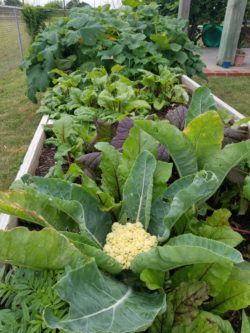
Ocean Guardian School Helps Feed Island Community During Pandemic
By Leslie Whaylen Clift, Constituency Affairs Coordinator for Flower Garden Banks National Marine Sanctuary
 Around the world, the COVID-19 pandemic continues to disrupt the lives, education, and finances of people everywhere. Meanwhile, nature continues unabated: dolphins frolic in ocean waves, birds undertake migration, and plants photosynthesize. In Galveston, Texas, vegetable gardens across the island have been growing uninterrupted for months with the absence of winter freezes this year. Within the last two years, most of Galveston’s public elementary schools have installed, planted, and maintained school gardens through the Young Gardeners Program. One of them, Oppe Elementary School, is also recognized as one of NOAA’s Ocean Guardian Schools.
Around the world, the COVID-19 pandemic continues to disrupt the lives, education, and finances of people everywhere. Meanwhile, nature continues unabated: dolphins frolic in ocean waves, birds undertake migration, and plants photosynthesize. In Galveston, Texas, vegetable gardens across the island have been growing uninterrupted for months with the absence of winter freezes this year. Within the last two years, most of Galveston’s public elementary schools have installed, planted, and maintained school gardens through the Young Gardeners Program. One of them, Oppe Elementary School, is also recognized as one of NOAA’s Ocean Guardian Schools.
Supported by the National Marine Sanctuary Foundation, an Ocean Guardian School pledges to protect and conserve its local watersheds and the world’s ocean. Schools formalize their commitment by developing and implementing a school- or community-based conservation project, with a focus on hands-on stewardship activities. After last year’s completion of projects across the system, more than 10,000 students, 360 teachers, and 53 schools participated in the program in 2018-2019, resulting in substantial impacts, including planting nearly 56,000 square meters of native plants. Each Ocean Guardian School chooses one of five pathways for its project: 1) watershed restoration; 2) marine debris; 3) schoolyard garden/habitat; 4) energy & ocean health; and 5) the 6Rs – rethink/refuse/reduce/reuse/rot/recycle. Oppe Elementary School in Galveston selected schoolyard garden/habitat.
When the pandemic struck, Oppe’s gardens teemed with produce: carrots, radishes, cauliflower, broccoli, cabbage, and all sorts of lettuces. Quickly, the community organized efforts to harvest and distribute the ripe produce (using social distancing guidelines). A local restaurant offered to temporarily provide refrigeration for the produce until distribution could be arranged. During this first harvest of the school gardens, volunteers harvested more than 200 pounds of fresh produce, distributed among 30 families specifically in need and local food pantries. This could be the end of the story, but it’s not.
Volunteers came together to plant the gardens again, keeping them flourishing, knowing more food would be needed in the community in the coming weeks and months. Seeds and seedlings went into the soil, chemical-free fertilizers were applied, and a watering schedule was distributed to volunteers. These school gardens have been deemed essential and as a result, have shifted into more high production gardening to grow as much food as possible. These efforts will continue until at least the beginning of summer.
For these last five weeks of the pandemic’s stay-at-home order, Oppe’s garden has provided a much-needed outlet in nature for my two children and me. One day each week, we bicycle to the school and spend a couple of hours cavorting through the vegetable beds. We water, weed, and trim. In doing so, we reap the benefits of sunshine, exercise, and gaining botanical knowledge and experience. Most importantly, we now feel the importance of what we are doing and how that translates into providing food to our community.
Thank you to the National Marine Sanctuary Foundation, NOAA, and other organizations such as Galveston’s Own Farmers Market for supporting Ocean Guardian Schools through its Young Gardeners Program. Thank you to the principals, teachers, students, families, and lead school gardeners who had the foresight to continue the school gardens even though schools are closed. These gardens are beacons of hope at a time of great struggle. Grow baby, grow!
Support Ocean Guardian Schools



